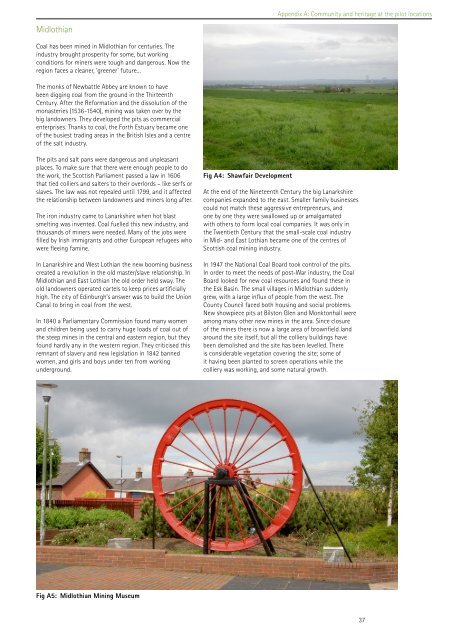Mine water as a Renewable Energy Resource - Promoscene
Mine water as a Renewable Energy Resource - Promoscene
Mine water as a Renewable Energy Resource - Promoscene
Create successful ePaper yourself
Turn your PDF publications into a flip-book with our unique Google optimized e-Paper software.
Midlothian<br />
Coal h<strong>as</strong> been mined in Midlothian for centuries. The<br />
industry brought prosperity for some, but working<br />
conditions for miners were tough and dangerous. Now the<br />
region faces a cleaner, ‘greener’ future...<br />
The monks of Newbattle Abbey are known to have<br />
been digging coal from the ground in the Thirteenth<br />
Century. After the Reformation and the dissolution of the<br />
mon<strong>as</strong>teries (1536-1540), mining w<strong>as</strong> taken over by the<br />
big landowners. They developed the pits <strong>as</strong> commercial<br />
enterprises. Thanks to coal, the Forth Estuary became one<br />
of the busiest trading are<strong>as</strong> in the British Isles and a centre<br />
of the salt industry.<br />
The pits and salt pans were dangerous and unple<strong>as</strong>ant<br />
places. To make sure that there were enough people to do<br />
the work, the Scottish Parliament p<strong>as</strong>sed a law in 1606<br />
that tied colliers and salters to their overlords – like serfs or<br />
slaves. The law w<strong>as</strong> not repealed until 1799, and it affected<br />
the relationship between landowners and miners long after.<br />
The iron industry came to Lanarkshire when hot bl<strong>as</strong>t<br />
smelting w<strong>as</strong> invented. Coal fuelled this new industry, and<br />
thousands of miners were needed. Many of the jobs were<br />
filled by Irish immigrants and other European refugees who<br />
were fleeing famine.<br />
In Lanarkshire and West Lothian the new booming business<br />
created a revolution in the old m<strong>as</strong>ter/slave relationship. In<br />
Midlothian and E<strong>as</strong>t Lothian the old order held sway. The<br />
old landowners operated cartels to keep prices artificially<br />
high. The city of Edinburgh’s answer w<strong>as</strong> to build the Union<br />
Canal to bring in coal from the west.<br />
In 1840 a Parliamentary Commission found many women<br />
and children being used to carry huge loads of coal out of<br />
the steep mines in the central and e<strong>as</strong>tern region, but they<br />
found hardly any in the western region. They criticised this<br />
remnant of slavery and new legislation in 1842 banned<br />
women, and girls and boys under ten from working<br />
underground.<br />
Fig A5: Midlothian Mining Museum<br />
Fig A4: Shawfair Development<br />
Appendix A: Community and heritage at the pilot locations<br />
At the end of the Nineteenth Century the big Lanarkshire<br />
companies expanded to the e<strong>as</strong>t. Smaller family businesses<br />
could not match these aggressive entrepreneurs, and<br />
one by one they were swallowed up or amalgamated<br />
with others to form local coal companies. It w<strong>as</strong> only in<br />
the Twentieth Century that the small-scale coal industry<br />
in Mid- and E<strong>as</strong>t Lothian became one of the centres of<br />
Scottish coal mining industry.<br />
In 1947 the National Coal Board took control of the pits.<br />
In order to meet the needs of post-War industry, the Coal<br />
Board looked for new coal resources and found these in<br />
the Esk B<strong>as</strong>in. The small villages in Midlothian suddenly<br />
grew, with a large influx of people from the west. The<br />
County Council faced both housing and social problems.<br />
New showpiece pits at Bilston Glen and Monktonhall were<br />
among many other new mines in the area. Since closure<br />
of the mines there is now a large area of brownfield land<br />
around the site itself, but all the colliery buildings have<br />
been demolished and the site h<strong>as</strong> been levelled. There<br />
is considerable vegetation covering the site; some of<br />
it having been planted to screen operations while the<br />
colliery w<strong>as</strong> working, and some natural growth.<br />
37


